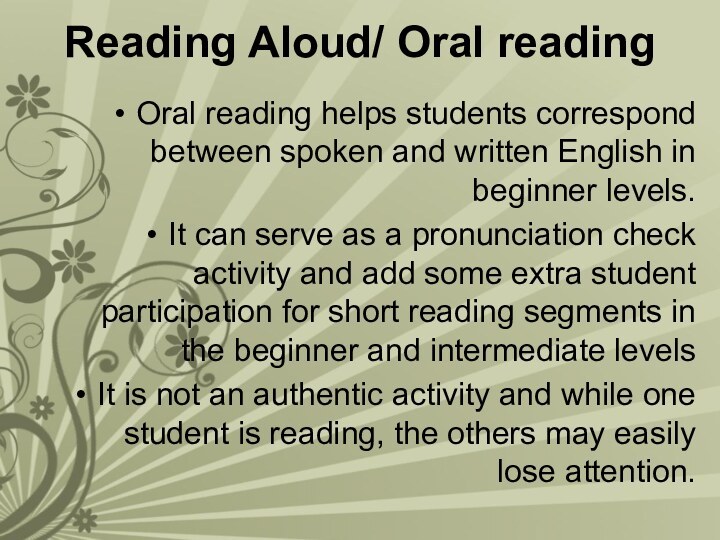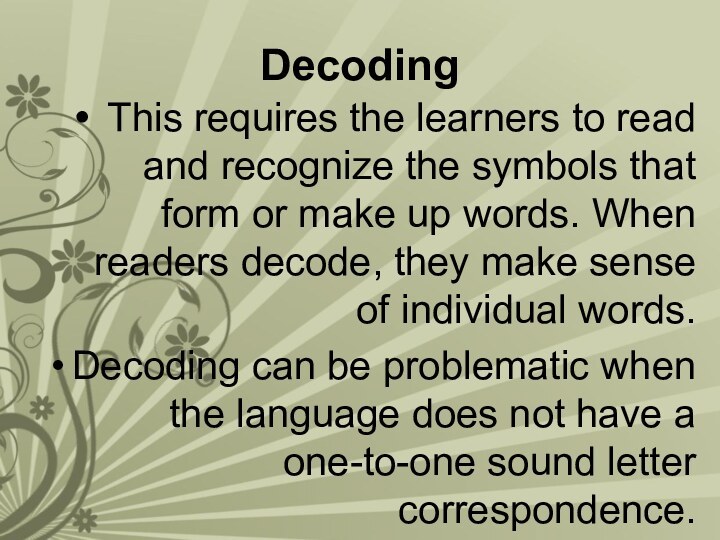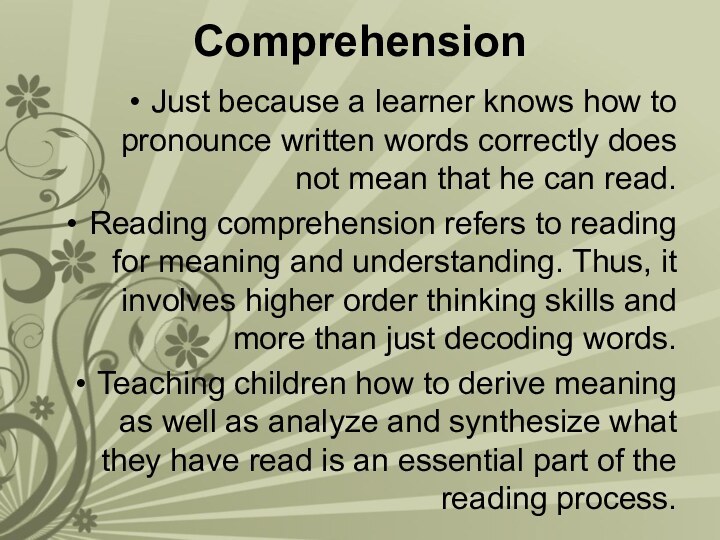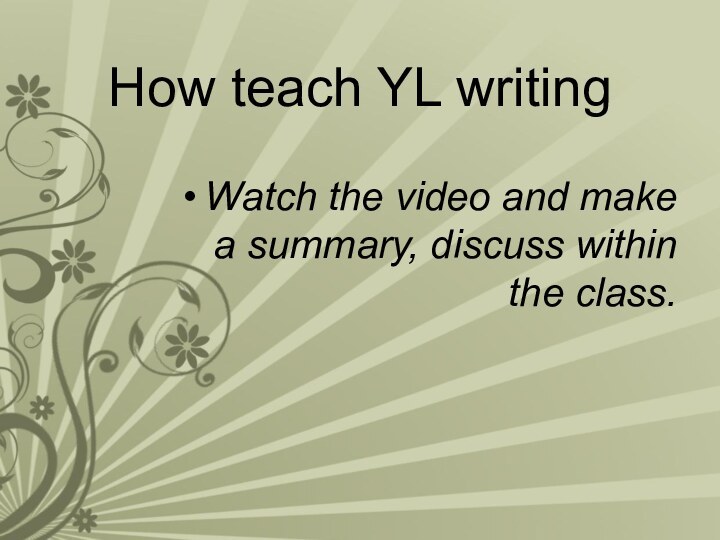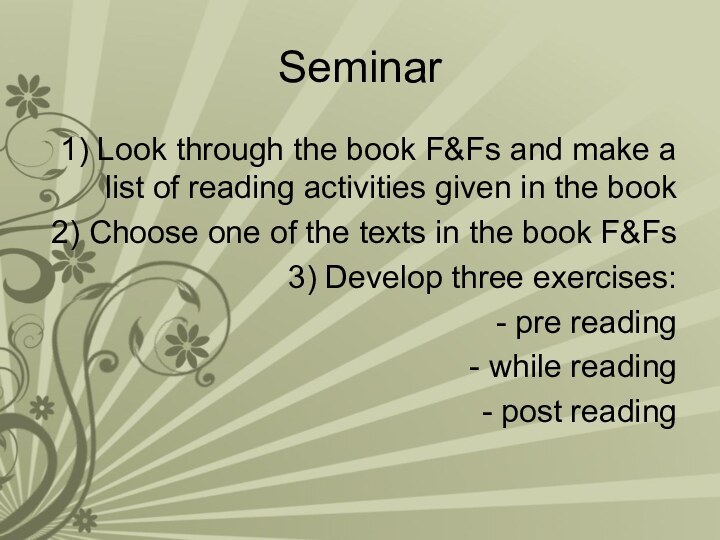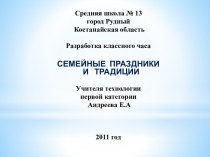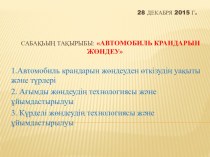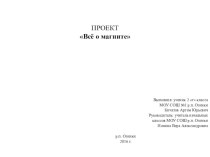Слайд 2
Strategies for teaching reading
Watch video and answer the
following questions:
What teaching reading is not?
Why reading aloud shouldn’t
be encouraged?
How do we teach reading?
What are the ways of preparing student for reading the text?
How can we make pre-reading exercises more effective?
What’s the recommended procedure for teaching reading?
How to deal with unknown vocabulary in the text?
Слайд 3
Important Concepts for Teaching Reading and Writing
in Young Learner Classes
Слайд 4
Extensive Reading
The teacher encourages the students to choose
for themselves what they read for pleasure and general
language improvement outside the class.
The students should read materials on the topics they are interested in and materials appropriate for their level.
Original fiction and non-fiction books, simplified works of literature, staged books, magazines can all be used.
In order to encourage extensive reading we can build up a library of suitable books, provide them with extensive reading tasks and encourage them to report back on the reading in different ways.
Слайд 5
Intensive reading
It is a classroom-oriented activity to have
students focus on the semantic and linguistic details.
In
order to encourage students to read enthusiastically in class, teachers need to create interest in the topic and tasks.
Teachers need to tell students the reading purpose, the instructions and time allocated. While the students are reading, the teachers may observe their progress but should not interrupt.
When the teachers ask students to give answers, they should always ask them to say where in the text they found the relevant information.
The teachers should focus on strategies to deal with the unknown vocabulary items.
Слайд 6
Bottom-up Processing: Magnifying glass
Readers must recognize
the linguistic signals (letters, syllables, words, phrases, discourse markers)
This data-driven processing requires a sophisticated knowledge of the language.
From the data, the reader selects the meaningful signal.
Слайд 7
Top-down Processing: Eagle’s eye view
Readers must
refer to their own intelligence and experience to predict
probable meaning and to understand a text.
This conceptually-driven processing requires readers to infer meaning.
Слайд 8
Schema or Background Knowledge
The readers bring information,
knowledge, emotion, memories, experience and culture to the printed
word.
Content schemata include what we know about people, the world, culture and the universe; Formal schemata include what we know about the discourse structure. While reading, they contribute to the text with more information than the text provides.
Skill in reading depends on the efficient interaction between linguistic knowledge and world knowledge.
Слайд 9
Interest and Culture
The love of reading has
propelled learners to successful acquisition of reading skills.
The
autonomy and self-esteem gained through reading strategies has been shown to be a powerful motivator.
Culture plays an important role in motivating and rewarding young learners for literacy.
Слайд 10
Teaching Vocabulary
Pre-teaching some of the vocabulary items
from the text helps reading comprehension for top-down processing.
Focusing on some of the vocabulary items after reading the text provides a detailed analysis of the text through bottom-up processing.
Слайд 11
Guessing Vocabulary
Using the contextual clues, the parts
of the word, world knowledge and cognates helps readers
to develop strategies to do not only intensive but also extensive reading.
Слайд 12
Reading Aloud/ Oral reading
Oral reading helps students
correspond between spoken and written English in beginner levels.
It can serve as a pronunciation check activity and add some extra student participation for short reading segments in the beginner and intermediate levels
It is not an authentic activity and while one student is reading, the others may easily lose attention.
Слайд 13
Silent Reading
Silent reading allows readers interact with
the text; thus, the teachers should not interrupt while
the students are reading.
Silent reading allows students to read at their own rate and to identify more than one word at a time.
The schemata and background knowledge and affective domain help the reader interact with the text.
Sustained silent reading develops a fluency in reading.
Слайд 14
Decoding
This requires the learners to read and
recognize the symbols that form or make up words.
When readers decode, they make sense of individual words.
Decoding can be problematic when the language does not have a one-to-one sound letter correspondence.
Слайд 15
Comprehension
Just because a learner knows how to
pronounce written words correctly does not mean that he
can read.
Reading comprehension refers to reading for meaning and understanding. Thus, it involves higher order thinking skills and more than just decoding words.
Teaching children how to derive meaning as well as analyze and synthesize what they have read is an essential part of the reading process.
Слайд 16
Reading for Pleasure
If a student knows that
s/he can get pleasure from reading stories in her
own language, she may be able to make the connection that reading in general can provide pleasure.
Fortunately, modern course books are increasingly using stories as a vital component, although they were ignored or were not made more use of for years.
Слайд 17
Reading for Information
Reading for information can be
as simple as reading a menu in a restaurant.
Reading for information can also give children pleasure, if they have a purpose in reading a text to learn something such as reading a cookbook, a book on model air planes, a book on dinosaurs.
Слайд 18
Teaching Reading
Teachers devote a great amount of
time to develop reading skills and strategies to help
students use the contextual clues (determine the meaning), make use of the background knowledge ( to activate schemata and to predict) and/or adapt different comprehension techniques (to organize the information the text)
Слайд 19
Assigning Reading
Teachers only ask students to read
and they check the answers.
This does not aim
to develop or improve skills or strategies of reading but to test the general reading ability.
Слайд 20
How teach YL writing
Watch the video and make
a summary, discuss within the class.
Слайд 21
There are 2 stages of writing
When teaching writing
to the children, we must recognize the complexity of
the process; that’s why it should be supported (ZPD and scaffolding).
This refers to the act of gathering ideas and working with them until they are presented in a manner that is polished and comprehensible to the readers.
It emphasizes the fluency in the writing process.
It is concerned with the final product of writing; in other words the essay, the project, the report, what that product should look like.
Writing is seen as a product and the students are evaluated according to what they write in this product.
The teacher tests writing rather than teaching it.
The student cannot make use of the feedback s/he receives.
Слайд 23
Seminar
1) Look through the book F&Fs and make
a list of reading activities given in the book
2)
Choose one of the texts in the book F&Fs
3) Develop three exercises:
- pre reading
- while reading
- post reading











